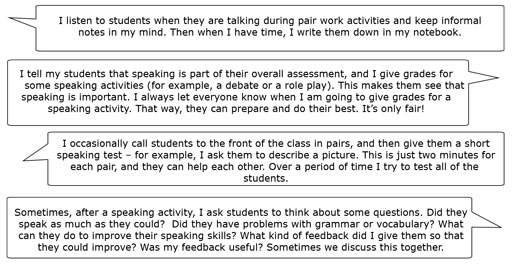3 How to assess your students’ skills in speaking English
Speaking is often one of the areas of learning English that is not usually assessed. However, speaking is an important skill for students to develop, and it is important to include activities in the English classroom that provide opportunities for students to speak in English. These could be telling a story, a role play, an interview or a discussion. Assessing speaking activities can tell you about your students’ progress in English, what they have learned, how confidently they can speak in English, or whether they are having problems speaking English.
Pause for thought Think about your students and classroom as you answer the next questions. If you can, discuss them with a colleague.
|
Now compare your thoughts with what some teachers do to assess speaking. Are any of these ideas possible for you and your class? Note the ones that are.
You can use any speaking activities to assess speaking skills, especially activities where students talk about themselves or an interesting topic. Activities such as reading a text aloud are not very useful for assessing speaking skills, as the only aspect of speaking that these activities assess is pronunciation. They don’t take other aspects of speaking into account such as speaking confidently and fluently, taking part in activities, using vocabulary and grammar accurately and so on.
Often in speaking activities students are demonstrating what they have understood from a reading or listening activity. So keep in mind that when you are assessing speaking, you are often assessing other skills at the same time.
Case Study 2: Mrs Agarwal assesses her students as they do a speaking activity
Mrs Agarwal teaches English to Class IX students in a non-English medium government secondary school. She tells about the last time she assessed her students’ speaking skills.
My class was doing an interview in English. They were working in groups of four [see Figure 1]. Two had written questions and were playing the role of journalists; the other two were taking it in turns to play the role of the interviewee (on this occasion, a famous film star).

I decided to listen and assess just two groups this time. Last time, I focused on other students, and next time I will focus on some different ones.
I keep a diary for my class, and in it I make notes and keep records of my students’ performance and grades. One part of my diary is related to speaking skills, with a grid showing names, the date and type of activity, and then different aspects of speaking [see Table 4].
| Names | Date and activity | Participation | Speaking confidently and with little hesitation (fluency) | Accurate use of grammar (accuracy) | Use of vocabulary | Pronunciation |
|---|---|---|---|---|---|---|
As my students carry out the speaking activity, I stand by them, listen and make notes [see Table 5].
| Names | Date and activity | Participation | Speaking confidently and with little hesitation (fluency) | Accurate use of grammar (accuracy) | Use of vocabulary | Pronunciation |
|---|---|---|---|---|---|---|
| Rahul | 06.01.14, interview | ✓✓ | ✓✓ | ✓✓ | ✓✓✓ | ✓✓ |
| Anju | 06.01.14, interview | ✓✓ | ✓✓✓ | ✓✓ | ✓✓ | ✓ |
You can see that I just use a simple ‘tick’ system. One tick means that the student is having problems; two ticks means that they are adequate; three ticks means that they are performing very well. The grid is very quick and easy to complete. I keep these informal records about students to help to get an understanding of each student’s progress and to contribute to their overall assessment. I then share my notes with the students so that they have a sense of their own abilities and what they need to work on.
Activity 3: Try in the classroom – using a record sheet to assess students’ speaking skills
In Case Study 2, Mrs Agarwal used a record sheet to informally assess students’ speaking skills, which she shares that with her students as feedback. Make a similar grid for your students, and try it out with one or two groups the next time your students are doing a speaking activity. You can use ticks, as in the case study, or you can add grades or comments. Make sure you let your students know what you are doing and share your feedback with them after the activity.
Pause for thought After trying a record sheet in your classroom, think about the following questions:
|
Feel free to change the grid. If it is difficult to use, simplify it and try again. If you find that one area is not as important as another, you can award more or fewer ticks. What is important is finding a grid that works for you and your students, and that allows you to collect information about your students’ speaking skills and share it with them in a way that is meaningful and will help them improve.
2 How to assess your students’ listening skills in reading and listening to English

